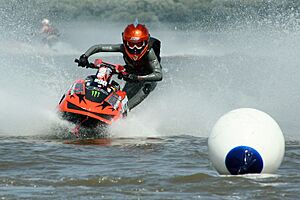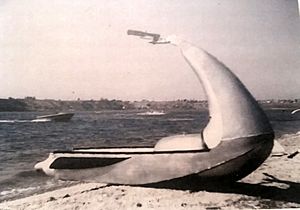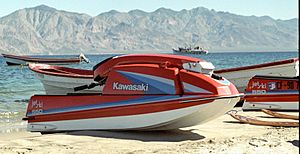Jet Ski facts for kids

Jet Ski DM 2007 during a race.
|
|
| Introduced | 1973 |
|---|---|
A Jet Ski is a special type of water vehicle made by a Japanese company called Kawasaki. It's like a motorcycle for the water! Even though Jet Ski is a brand name, many people use it to talk about any personal watercraft (PWC) they ride for fun. You might even hear people say they are "jet skiing" when they are riding any PWC.
Most personal watercraft, like the "runabout" style, let one to three people sit down. It feels a lot like riding a bicycle or a motorcycle on the water.
Contents
Kawasaki Jet Ski: The Original Water Ride
The name "Jet Ski" is a special brand name owned by Kawasaki. In 1972, Kawasaki launched its first stand-up Jet Ski. This was the first personal watercraft that became really popular in America. Kawasaki worked with Clayton Jacobson II, who invented the Sea-Doo, to make this happen.
For almost 16 years, the Kawasaki Jet Ski was the only super popular personal watercraft. This was from 1972 until 1988. That's when the sit-down Sea-Doo came back.
Jet Ski Racing and Sports
When the Jet Ski first came out, Kawasaki helped create a group for Jet Ski riders. It was called the United States Jet Ski Boating Association (USJSBA). Later, in 1982, its name changed to the International Jet Sports Boating Association (IJSBA).
At first, only the stand-up JS440 Jet Skis were used in races. But in 1986, Kawasaki introduced a sit-down model called the X2. This new model got its own racing group, which was later called the "Sport Class."
Stand-Up Jet Ski Models Through the Years
Early Models: 1972–1976
Kawasaki released its first stand-up personal watercraft in October 1972. These early models, the WSAA and WSAB, had 400cc 2-stroke engines. The WSAA had a flat bottom, while the WSAB had a V-shaped bottom.
These early Jet Skis had cool safety features. The engine's propeller was fully covered. Also, if you fell off, the Jet Ski would right itself and circle around. This meant you could swim back to it while it was idling. Before they settled on "Jet Ski," Kawasaki called them "Water Jet" and "Power Skis."
Growing Power: 1976–1982
The 1976 JS400 was a big hit with people who loved thrills and racing. The 1977 JS440 offered even more power. It was one of Kawasaki's most popular models for a long time.
In 1982, Kawasaki launched the JS550. This model had even better performance. It featured a new, powerful pump and a 531cc engine. The JS550 also had a special system to protect the engine from damage. Plus, it had an underwater exhaust, which made it quieter.
New Designs: 1982–1986
While the JS550 kept getting better, Kawasaki introduced the JS300 in 1986. This model had a smaller 294cc engine and used automatic oil injection.
In the same year, they also added the 650 X2. This was their very first sit-down Jet Ski. It started the "Sport Class" for personal watercraft racing.
More Power and Control: 1987–1992
Kawasaki introduced the JS650SX. It had a stronger pump and a powerful 635cc 2-stroke engine. Its hull (the bottom part) was designed to make it easier to steer and more stable.
In 1992, the company released the stand-up JS750-A. This model had a 743cc 2-stroke engine with automatic oil injection. The new hull was lighter and even easier to maneuver.
Dual Carburetors and Beyond: 1995–2011
In 1995, the 750 SXI (JS750-B) came out. It was the first stand-up Jet Ski to have two carburetors.
In 2003, Kawasaki introduced the SX-R 800 (JS800A). This model had a larger 781cc 2-stroke engine, making 80 horsepower. The SX-R also used a new fiberglass material for its hull.
In 2006, Kawasaki released the X2 800 (JF800A). This was an updated version of the earlier 650cc X2.
By 2011, due to environmental rules, Kawasaki stopped making their 2-stroke stand-up Jet Skis. The JS800 SX-R was the last of its kind.
The Return of the Stand-Up: 2017
On October 6, 2016, Kawasaki brought back the stand-up Jet Ski! The new SX-R 1500 was very different from older models. It was longer and heavier. It was powered by a strong 160 horsepower 4-cylinder 4-stroke engine.
Other Stand-Up Watercraft Makers
In 1990, Yamaha introduced their own stand-up model called the Super Jet. This was also designed with help from Clayton Jacobson II. For many years, it used a 2-stroke engine. But starting with the 2021 model, it switched to a 4-stroke engine.
Yamaha also made a limited number of FX-1 models in 1994–1995.
Other companies have made stand-up personal watercraft too:
- From 2002 to 2004, Polaris made the Octane.
- In the mid-2000s, Benelli made the S4 Hydrospace.
- From 2005 to 2007, Bombardier introduced the Sea-Doo 3D.
Many companies also make special parts for stand-up personal watercraft, especially for racing.
See also
 In Spanish: Jet Ski para niños
In Spanish: Jet Ski para niños
- Jet ski fishing
- Personal watercraft
- Flyboard
- Flyboarding
- Jetboat
- Jetboard
- Surfing
- Kiteboarding
- Water Ski Racing
- Wakeboarding




